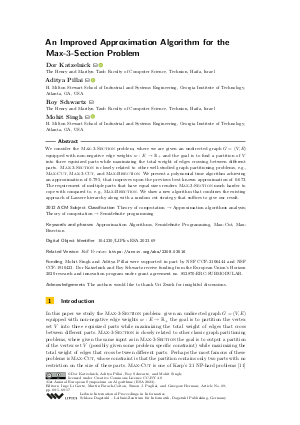An Improved Approximation Algorithm for the Max-3-Section Problem
Authors
Dor Katzelnick  ,
Aditya Pillai
,
Aditya Pillai  ,
Roy Schwartz,
Mohit Singh
,
Roy Schwartz,
Mohit Singh 
-
Part of:
Volume:
31st Annual European Symposium on Algorithms (ESA 2023)
Part of: Series: Leibniz International Proceedings in Informatics (LIPIcs)
Part of: Conference: European Symposium on Algorithms (ESA) - License:
 Creative Commons Attribution 4.0 International license
Creative Commons Attribution 4.0 International license
- Publication Date: 2023-08-30
File

PDF
LIPIcs.ESA.2023.69.pdf
- Filesize: 0.87 MB
- 17 pages
Document Identifiers
Related Versions
- Full Version https://arxiv.org/abs/2308.03516
Subject Classification
ACM Subject Classification
- Theory of computation → Approximation algorithms analysis
- Theory of computation → Semidefinite programming
Keywords
- Approximation Algorithms
- Semidefinite Programming
- Max-Cut
- Max-Bisection
Metrics
- Access Statistics
-
Total Accesses (updated on a weekly basis)
0PDF Downloads0Metadata Views
Abstract
We consider the Max--Section problem, where we are given an undirected graph G=(V,E)equipped with non-negative edge weights w: E → R_+ and the goal is to find a partition of V into three equisized parts while maximizing the total weight of edges crossing between different parts. Max-3-Section is closely related to other well-studied graph partitioning problems, e.g., Max-Cut, Max-3-Cut, and Max-Bisection. We present a polynomial time algorithm achieving an approximation of 0.795, that improves upon the previous best known approximation of 0.673. The requirement of multiple parts that have equal sizes renders Max-3-Section much harder to cope with compared to, e.g., Max-Bisection. We show a new algorithm that combines the existing approach of Lassere hierarchy along with a random cut strategy that suffices to give our result.
Cite As Get BibTex
Dor Katzelnick, Aditya Pillai, Roy Schwartz, and Mohit Singh. An Improved Approximation Algorithm for the Max-3-Section Problem. In 31st Annual European Symposium on Algorithms (ESA 2023). Leibniz International Proceedings in Informatics (LIPIcs), Volume 274, pp. 69:1-69:17, Schloss Dagstuhl – Leibniz-Zentrum für Informatik (2023)
https://doi.org/10.4230/LIPIcs.ESA.2023.69
BibTex
@InProceedings{katzelnick_et_al:LIPIcs.ESA.2023.69,
author = {Katzelnick, Dor and Pillai, Aditya and Schwartz, Roy and Singh, Mohit},
title = {{An Improved Approximation Algorithm for the Max-3-Section Problem}},
booktitle = {31st Annual European Symposium on Algorithms (ESA 2023)},
pages = {69:1--69:17},
series = {Leibniz International Proceedings in Informatics (LIPIcs)},
ISBN = {978-3-95977-295-2},
ISSN = {1868-8969},
year = {2023},
volume = {274},
editor = {G{\o}rtz, Inge Li and Farach-Colton, Martin and Puglisi, Simon J. and Herman, Grzegorz},
publisher = {Schloss Dagstuhl -- Leibniz-Zentrum f{\"u}r Informatik},
address = {Dagstuhl, Germany},
URL = {https://drops.dagstuhl.de/entities/document/10.4230/LIPIcs.ESA.2023.69},
URN = {urn:nbn:de:0030-drops-187229},
doi = {10.4230/LIPIcs.ESA.2023.69},
annote = {Keywords: Approximation Algorithms, Semidefinite Programming, Max-Cut, Max-Bisection}
}
Author Details
- H. Milton Stewart School of Industrial and Systems Engineering, Georgia Institute of Technology, Atlanta, GA, USA
Funding
Mohit Singh and Aditya Pillai were supported in part by NSF CCF-2106444 and NSF CCF-1910423. Dor Katzelnick and Roy Schwartz receive funding from the European Union’s Horizon 2020 research and innovation program under grant agreement no. 852870-ERC-SUBMODULAR.
Acknowledgements
The authors would like to thank Uri Zwick for insightful discussions.
References
-
Gunnar Andersson. An approximation algorithm for max p-section. In STACS 99: 16th Annual Symposium on Theoretical Aspects of Computer Science Trier, Germany, March 4-6, 1999 Proceedings, pages 237-247. Springer, 2002.

-
Per Austrin, Siavosh Benabbas, and Konstantinos Georgiou. Better balance by being biased: A 0.8776-approximation for max bisection. ACM Trans. Algorithms, 13(1):2:1-2:27, 2016.

-
Etienne De Klerk, Dmitrii Pasechnik, Renata Sotirov, and Cristian Dobre. On semidefinite programming relaxations of maximum k-section. Mathematical programming, 136(2):253-278, 2012.

-
Etienne de Klerk, Dmitrii V Pasechnik, and Joost P Warners. On approximate graph colouring and max-k-cut algorithms based on the θ-function. Journal of Combinatorial Optimization, 8:267-294, 2004.

-
Uriel Feige and Michael Langberg. The rpr2 rounding technique for semidefinite programs. Journal of Algorithms, 60(1):1-23, 2006.

-
Alan Frieze and Mark Jerrum. Improved approximation algorithms for max k-cut and max bisection. Algorithmica, 18(1):67-81, 1997.

-
Daya Ram Gaur, Ramesh Krishnamurti, and Rajeev Kohli. The capacitated max k-cut problem. Mathematical Programming, 115:65-72, 2008.

-
Michel X Goemans and David Williamson. Approximation algorithms for max-3-cut and other problems via complex semidefinite programming. In Proceedings of the thirty-third annual ACM symposium on Theory of computing, pages 443-452, 2001.

-
Michel X Goemans and David P Williamson. Improved approximation algorithms for maximum cut and satisfiability problems using semidefinite programming. Journal of the ACM (JACM), 42(6):1115-1145, 1995.

-
Eran Halperin and Uri Zwick. A unified framework for obtaining improved approximation algorithms for maximum graph bisection problems. Random Structures & Algorithms, 20(3):382-402, 2002.

-
Richard M Karp. Reducibility among combinatorial problems. Complexity of Computer Computations, 1972.

-
Subhash Khot, Guy Kindler, Elchanan Mossel, and Ryan O'Donnell. Optimal inapproximability results for MAX-CUT and other 2-variable csps? SIAM J. Comput., 37(1):319-357, 2007.

-
Ai-fan Ling. Approximation algorithms for max 3-section using complex semidefinite programming relaxation. In Combinatorial Optimization and Applications: Third International Conference, COCOA 2009, Huangshan, China, June 10-12, 2009. Proceedings 3, pages 219-230. Springer, 2009.

-
Alantha Newman. Complex semidefinite programming and max-k-cut. In SIAM Symposium on Simplicity in Algorithms, 2018.

-
Prasad Raghavendra and Ning Tan. Approximating csps with global cardinality constraints using SDP hierarchies. In SODA, pages 373-387. SIAM, 2012.

-
Yinyu Ye. A .699-approximation algorithm for max-bisection. Mathematical Programming, 90(1):101-111, March 2001.

